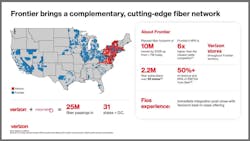Verizon snaps up Frontier for $20B in bid to bolster fiber broadband base
Verizon Communications has reached a deal to acquire Frontier Communications for $20 billion, aiming to enhance its fiber broadband and fixed and mobile wireless services base.
Hans Vestberg, CEO of Verizon, said the acquisition of Frontier will create more broadband and wireless connectivity (both mobile wireless and fixed wireless access) choices for consumers and businesses.
Fiber and Fixed Wireless Access (FWA) have added over 100% of industry net add growth during the last five quarters.
“With Frontier’s fiber added to our portfolio, we will be the only carrier that will have size and scale in both fiber and fixed wireless access,” Hansberg said.
All about scale
Through this acquisition, Verizon will increase its fiber broadband network scale.
Verizon and Frontier have approximately 10 million fiber customers across 31 states and Washington D.C., with fiber networks passing over 25 million premises. Both companies expect to increase their fiber penetration between now and closing.
Verizon will gain access to Frontier’s customer base in markets highly complementary to Verizon’s core Northeast and Mid-Atlantic markets. Frontier’s footprint offers substantial room for increased penetration in both fiber and mobility services, and Verizon is well-positioned with stores throughout Frontier’s territory.
Verizon will integrate Frontier’s fiber network into Verizon's portfolio of fiber and wireless assets, including its Fios offering.
Over the past four years, Frontier has invested $4.1 billion in upgrading and expanding its fiber network and now derives more than 50% of its revenue from fiber products.
Frontier’s 2.2 million fiber subscribers across 25 states will join Verizon’s approximately 7.4 million Fios connections in 9 states and Washington, D.C. In addition to Frontier’s 7.2 million fiber locations, the company is committed to building out an additional 2.8 million fiber locations by the end of 2026.
Vestberg said that in the near term, Verizon is committed to expanding the Fios footprint to 400,000 to 500,00 new locations this year,” adding it will return to it when “it takes the next steps with its broadband strategy."
Interestingly, Fios continues help drive up wireless service adoption. Verizon has seen its wireless share rise where it offers Fios today. The company sees an opportunity to scale that in the new markets it will gain via the acquisition of Frontier.
“In markets where we have Fios today, our wireless share is 400 to 500 basis points higher in those markets where we don’t have fiber,” said Sampath Sowmyanarayan, EVP and CEO for Verizon Consumer Group. “Over a period of time once we close the Frontier deal, we expect our wireless share in the Frontier markets to grow.”
Likewise, Sowmyanarayan added that it will enhance fiber growth within Frontier’s existing markets.
“On fiber penetration, we will bring the power of the Verizon retail fleet and the power of our distribution in the Frontier markets,” he said. “With that you are going to see higher penetration once we close on the Frontier acquisition.”
Wireline/wireless convergence opportunities
This deal focuses on extending its larger range of mobile and fixed wireless access (FWA) services to more consumers and businesses. The provider can now also capitalize on opportunities to offer converged service packages that bundle fiber broadband and wireless.
Vestberg previously said during its second-quarter earnings call that the provider is well-positioned to support customers who want a converged service experience.
One of Verizon’s initial moves was to allow customers to customize their mobile and broadband plans with its myHome program.
myHome allows customers to customize how they get broadband and content. As part of the new program, an extension of its popular myPlan mobile offering, it has an always-on guaranteed phone trade-in program for new and existing mobility customers.
Verizon said that Frontier customers and those previously outside Verizon’s fiber footprint will have more choice and access to Verizon’s premium mobility, home internet, streaming, and connected home offerings, alongside premium business products like Verizon Business Complete.
As of the end of the second quarter, Verizon added 391,000 broadband subscribers, including 28,000 Fios internet net additions and 378,000 Fixed Wireless Access net additions.
Vestberg sees an opportunity to unite the two companies' wireless and wireline assets. Having added 90,000 new fiber subscribers in the second quarter, Frontier has 2.1 million fiber subscribers.
“We have the opportunity to unite Frontier’s premium fiber with Verizon’s premium mobile offering, which is a powerful and strategic combination,” he said. “Our team has demonstrated we can create value with mobile and home convergence in the Fios space.”
Jeff Heynen, VP at Dell’Oro Group, said the acquisition highlights providers' ability to offer converged wireless/wireline services.
“This deal shows just how important the idea of convergence is for service providers,” he said. “The mobile-fiber bundle is turning out to be very attractive to consumers. So, if Verizon can scale that across a footprint of nearly 25 million homes (and growing), while also reducing the costs to provide those services and increasing EBITDA, it will position itself for long-term success, especially since the demand for fiber where it’s available remains high.”
He added that telcos like Verizon see an opportunity to break cable’s stronghold on the broadband market.
While cable had consistently enjoyed several quarters of broadband growth, the cracks in recent quarters have begun to show. During the second quarter, Comcast and Charter saw sharp broadband subscriber declines. Comcast lost 120,000 broadband subscribers, while Charter lost 154,000.
“The telcos smell blood among their cable competitors,” Heynen said. “They have seen Comcast and Charter now consistently lose subscribers to both fiber and fixed wireless and they sense that fiber and convergence are the ticket to ending cable’s dominance in the US. If true, scaling your network and fiber footprint is the best way to take advantage of this shift in subscriber preference.”
Enhancing BEAD
This deal could also impact Verizon’s and Frontier’s Broadband Equity and Access Deployment (BEAD) status.
According to July 2023 New Street Research, there are slightly over 600,000 BEAD subsidy-eligible locations within Verizon’s ILEC territory.
In April, Verizon won a sizeable grant from the State of Pennsylvania. The company is slated to take home about $78.3 million out of $204 million awarded.
Frontier created a grants team and has done data modeling to address the BEAD opportunity. Also, Frontier has already included BEAD eligible locations and adjacent areas into its build models.
However, Vestberg said Verizon and Frontier will continue with its BEAD plans as they have been publicly disclosed.
Frontier previously set a goal to bring fiber to 10 million locations by the end of 2025, and it will be about 80% of the way there by the end of this year.
“There’s no change on the BEAD strategy,” he said. “Based on this, the only thing we can confirm is Frontier’s plans to add 3 million passings and we’ll continue to support it.”
Heynen said that BEAD along with other government funding programs like ARPA and RDOF will provide service providers an opportunity to expand their “fiber footprint at reasonable costs organically.”
“Today's rural areas will be tomorrow’s suburbs and potentially tomorrow’s urban areas,” he said. “If you can build out those networks today for 50-70% less capital, then you take that deal because the potential for future customer relationships is enormous. Once again, the best way to capture those current and future subscribers is to have scale.”
For related articles, visit the Broadband Topic Center.
For more information on high-speed transmission systems and suppliers, visit the Lightwave Buyer’s Guide.
To stay abreast of fiber network deployments, subscribe to Lightwave’s Service Providers and Datacom/Data Center newsletters.
Fiber M&A picks up
Fiber broadband network acquisition activity has continued to rise amongst an array of large Tier 1 and even Tier 2 service providers.
Besides Verizon, T-Mobile has been the most aggressive on the fiber broadband acquisiton front.
In April, the wireless operator announced a deal to acquire Lumos Networks for $1 billion through a joint venture with EQT. By 2026, the company plans to bring services to 2 million homes in underserved markets.
Later, in August, T-Mobile reached a deal to establish a joint venture with KKR to acquire fiber broadband provider Metronet. This move reflects the wireless operator’s desire to build a fiber-to-the-home (FTTH) business to complement its growing broadband arsenal.
The JV will acquire Oak Hill Capital’s existing stake as part of the deal. Oak Hill Capital will re-invest to retain a minority position, and founder John Cinelli will keep it once the deal closes.
But fiber M&A is not relegated just to large provdiers. Smaller providers like Shentel are also active in the fiber M&A arena.
Shentel recently completed its acquisition of Horizon Telecom, which gave the independent telco immediate entry into the growing Ohio broadband market.
Since buying Horizon, Shentel announced plans to expand its the Glo Fiber network to Greenfield, Hillsboro, Jackson, Johnstown, and Zanesville, Ohio. This move will enable the company to extend Glo Fiber into new markets in Ohio while doubling the size of the telco’s commercial fiber business.
About the Author
Sean Buckley
Sean is responsible for establishing and executing the editorial strategy of Lightwave across its website, email newsletters, events, and other information products.




